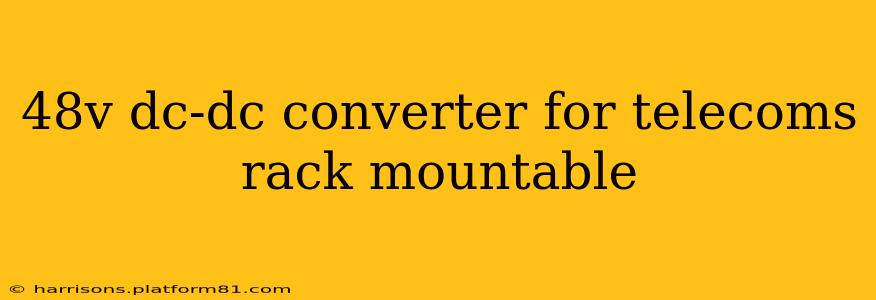The telecommunications industry relies heavily on robust and efficient power conversion solutions. 48V DC-DC converters are essential components in telecom racks, providing clean and regulated power to sensitive equipment. This guide explores the key features, considerations, and applications of rack-mountable 48V DC-DC converters designed for the demanding environment of a telecom infrastructure.
What are 48V DC-DC Converters?
48V DC-DC converters are power electronic devices that transform a 48V DC input voltage into a lower or higher DC voltage, offering isolation and regulation. In telecom applications, they are crucial for powering various equipment, including routers, switches, and other network devices, often requiring different voltage levels. These converters ensure stable power delivery despite fluctuations in the input voltage, protecting sensitive components from damage. Rack-mountable designs allow for seamless integration within existing telecom infrastructure.
Why are Rack-Mountable Converters Essential in Telecoms?
The need for rack-mountable 48V DC-DC converters in telecoms stems from several key factors:
-
Space Optimization: Telecom racks are densely packed with equipment. Rack-mountable converters maximize space utilization by fitting neatly into standard rack units (U), eliminating clutter and improving airflow.
-
Ease of Installation and Maintenance: A standardized rack-mount design simplifies installation and maintenance, allowing for easy access and replacement of units without disrupting the entire system.
-
Centralized Power Management: Rack-mounting allows for centralized power distribution and monitoring, simplifying troubleshooting and improving overall system reliability.
-
Environmental Protection: Rack-mountable converters are typically designed to meet industry standards for thermal management and electromagnetic interference (EMI) shielding, protecting sensitive equipment from harsh environmental conditions.
What are the Key Features of a Telecom-Grade 48V DC-DC Converter?
High-quality telecom-grade 48V DC-DC converters typically include the following features:
-
High Efficiency: Minimizing power loss is crucial in telecom applications. High-efficiency converters reduce operational costs and heat dissipation.
-
Wide Input Voltage Range: The ability to handle fluctuations in the input voltage ensures stable operation even during power surges or dips.
-
Multiple Outputs: Many converters provide multiple isolated outputs to power various devices with different voltage requirements.
-
High Reliability: Telecom applications demand high reliability and uptime. Converters should feature robust design, protection mechanisms (over-current, over-voltage, short-circuit), and long operational lifespans.
-
Remote Monitoring Capabilities: Some advanced models offer remote monitoring capabilities, enabling proactive maintenance and fault detection.
-
Compliance with Industry Standards: Compliance with relevant safety and environmental standards (e.g., IEC, UL, and CE) is essential for reliable operation and safety.
What are the different types of 48V DC-DC converters used in Telecoms?
Several types of 48V DC-DC converters cater to various telecom needs:
-
Isolated Converters: Offer galvanic isolation between input and output, protecting sensitive equipment from ground loops and surges.
-
Non-Isolated Converters: Simpler and less expensive but lack isolation. Suitable for applications where isolation isn't critical.
-
Redundant Converters: Provide backup power in case of primary converter failure, ensuring high availability.
How do I choose the right 48V DC-DC converter for my telecom rack?
Selecting the appropriate converter involves considering several factors:
-
Required Output Voltage and Current: Determine the power requirements of the devices being powered.
-
Input Voltage Range: Match the converter's input voltage range to the available power supply.
-
Efficiency: Choose a high-efficiency converter to minimize energy loss and heat generation.
-
Size and Mounting: Ensure the converter fits within the available rack space.
-
Protection Features: Select a converter with appropriate over-current, over-voltage, and short-circuit protection.
-
Reliability and MTBF: Look for converters with a high mean time between failures (MTBF) for greater operational uptime.
What are the potential challenges and solutions when using 48V DC-DC converters in Telecoms?
Challenges can include:
-
Heat Dissipation: High-power converters can generate significant heat. Proper ventilation and heat sinking are crucial.
-
EMI/RFI: Converters can generate electromagnetic interference (EMI) or radio frequency interference (RFI). Shielding and filtering are necessary to mitigate these issues.
-
Overload Protection: Choosing a converter with robust overload protection is crucial to prevent damage to equipment in the event of unexpected surges.
Conclusion
48V DC-DC converters are critical components in modern telecom infrastructure, providing reliable and efficient power conversion for sensitive network equipment. By carefully considering the key features, selecting the right converter for your specific needs, and addressing potential challenges, you can ensure the stable and reliable operation of your telecom network. Remember to consult with a power specialist for guidance on complex deployments or high-power applications.
